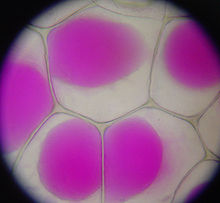Lysis
Lysis (/ˈlaɪsɪs/ LY-sis) is the breaking down of the membrane of a cell, often by viral, enzymic, or osmotic (that is, "lytic" /ˈlɪtɪk/ LIT-ik) mechanisms that compromise its integrity. A fluid containing the contents of lysed cells is called a lysate. In molecular biology, biochemistry, and cell biology laboratories, cell cultures may be subjected to lysis in the process of purifying their components, as in protein purification, DNA extraction, RNA extraction, or in purifying organelles.
Many species of
Cytolysis
Cytolysis occurs when a cell bursts due to an osmotic imbalance that has caused excess water to move into the cell.
Cytolysis can be prevented by several different mechanisms, including the contractile vacuole that exists in some paramecia, which rapidly pump water out of the cell. Cytolysis does not occur under normal conditions in plant cells because plant cells have a strong cell wall that contains the osmotic pressure, or turgor pressure, that would otherwise cause cytolysis to occur.
Oncolysis
Oncolysis is the destruction of
The term is also used to refer to the reduction of any
Plasmolysis

Plasmolysis is the contraction of cells within plants due to the loss of water through osmosis. In a hypertonic environment, the cell membrane peels off the cell wall and the vacuole collapses. These cells will eventually wilt and die unless the flow of water caused by osmosis can stop the contraction of the cell membrane.[5]
Immune response
Erythrocytes' hemoglobin release
Applications
Cell lysis is used in laboratories to break open cells and purify or further study their contents. Lysis in the laboratory may be affected by enzymes or detergents or other chaotropic agents. Mechanical disruption of cell membranes, as by repeated freezing and thawing, sonication, pressure, or filtration may also be referred to as lysis. Many laboratory experiments are sensitive to the choice of lysis mechanism; often it is desirable to avoid mechanical shear forces that would denature or degrade sensitive macromolecules, such as proteins and DNA, and different types of detergents can yield different results. The unprocessed solution immediately after lysis but before any further extraction steps is often referred to as a crude lysate.[8][9]
For example, lysis is used in
Methods
Chemical lysis
This method uses chemical disruption. It is the most popular and simple approach. Chemical lysis chemically deteriorates/solubilizes the proteins and lipids present within the membrane of targeted cells.[10]
Acoustic lysis
This method uses ultrasonic waves to generate areas of high and low pressure which causes cavitation and in turn, cell lysis. Though this method usually comes out clean, it fails to be cost effective and consistent.[11]
Mechanical lysis
This method uses physical penetration to pierce or cut a cell membrane.[12]
Enzymatic lysis
This method uses enzymes such as lysozyme or proteases to disintegrate the cell membrane.[13]
See also
References
- ISBN 978-3-7643-5121-2.
- PMID 11259652.
- ISBN 978-0-19-975971-2.
- ^ "Oncolysis". Medical Dictionary. Farlex. Retrieved 27 March 2013.
- doi:10.1111/j.1469-8137.1994.tb02952.x. Archived from the originalon May 22, 2011. Retrieved 2008-09-11.
- ^ Shobana Kesava (1 September 2007). "Red blood cells do more than just carry oxygen. New findings by NUS team show they aggressively attack bacteria too" (PDF). The Straits Times. Archived from the original (PDF) on 2009-02-20 – via Department of Biological Sciences, National University of Singapore.
- (PDF) from the original on Jan 12, 2024.
- ^ a b Thermo Scientific Pierce Cell Lysis Technical Handbook (PDF) (2 ed.). Thermo Scientific.
- ^ a b "Protein Expression and Purification Core Facility: Protein Purification: Extraction and Clarification". European Molecular Biology Laboratory. Retrieved 17 March 2015.
- PMID 24759281.
- PMID 24759281.
- PMID 24759281.
- S2CID 251132821.
